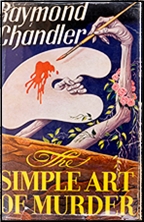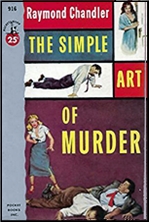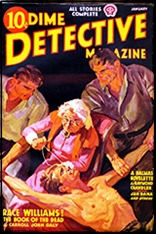Sat 28 Mar 2020
A 1001 Midnights Review by Bill Pronzini: RAYMOND CHANDLER – The Simple Art of Murder.
Posted by Steve under 1001 Midnights , Pulp Fiction , Reviews[5] Comments
by Bill Pronzini
RAYMOND CHANDLER – The Simple Art of Murder. Houghton Mifflin, hardcover, 1950. Pocket #916, paperback, 1953. Reprinted many times since, in both hardcover and paperback.

Eleven of the twelve stories in is collection are those that Chandler considered the best of his output for the pulps; the other story, “I’ll Be Waiting†was first published in the Saturday Evening Post (although Chandler admittedly felt uncomfortable and restricted writing for the slick-magazine medium). Also included here is Chandler’s famous and controversial essay on detective fiction, first published in the Atlantic Monthly, in which he lauds Hammett and the realistic school of crime writing, and takes a number of shots (some fair, some cheap) at such Golden Age luminaries as Christie, Sayers, and A. A. Milne.

The stories here, as the dust jacket blurb says with typical publishers’ overstatement bur accurately nonetheless “hit you as hard as if [Chandler] were driving the last spike on the first continental railroad.” “Red Wind,” for instance, begins with one of the finest opening paragraphs in the history of the genre:

In the original appearance of that story, the private-eye narrator was Johnny Dalmas; here he becomes Philip Marlowe. Similarly, the unnamed narrator in “Finger Man,“ Carmady in “Goldfish,” and Dalmas again in “Trouble 1s My Business” are also changed to Marlowe. Johnny Dalmas does get to keep his own name in “Smart-Aleck Kill,” no doubt because that novelette is told third-person.
And the same is true of Carmady in “Guns at Cyrano’s.†The only other first person story in the collection, the lighter-toned and somewhat wacky “Pearls Are a Nuisance,” features a much more refined dick named Walter Gage whose antics in search of a string of forty-nine matched pink pearls provide chuckles as well as thrills. Also included arc the tough Black Mask novelettes “Nevada Gas” and “Spanish Blood,” “The King in Yellow†from Dime Detective and “‘Pick-Up on Noon Street” from Detective Fiction Weekly.

All of these stories appear in several other collections, such the paperback originals Five Murderers (1944) and Finger Man and Other Stories (1946) and the Tower Books hardcover originals Red Wind (1946) and Spanish Blood (1946). Next to The Simple Art of Murder, the most interesting and important Chandler collection is Killer in the Rain (1964), which gathers the eight “cannibalized” stories that were used as the bases for The Big Sleep, Farewell. My Lovely, and The Lady in the Lake.
———
Reprinted with permission from 1001 Midnights, edited by Bill Pronzini & Marcia Muller and published by The Battered Silicon Dispatch Box, 2007. Copyright © 1986, 2007 by the Pronzini-Muller Family Trust.
March 28th, 2020 at 2:15 pm
I love these stories, every one mentioned. It’s been too long since I’ve read them!
March 28th, 2020 at 2:45 pm
For PI fans, these are the best of the best. (And even if you’re not.)
March 28th, 2020 at 6:56 pm
I couldn’t help but laugh at an episode of the Geraldine McEwen Miss Marple series that has her reading THE SIMPLE ART OF MURDER.
While I have many disagreements with Chandler his essay is still one of essential statements about the genre and mystery in general, and the book is a great collection of his short fiction.
I know there are those who like to deny Chandler his position in the genre, argue he isn’t as pure as Hammett, as artistic as Macdonald, or that his prejudices, those of a man of this time, disqualify him somehow and make what he said and wrote less, but even from writers and critics I like it always sounds like sour grapes.
Chandler defines the genre in a way no other writer has, even Hammett, his voice, his creations, his use of language, simile, and metaphor are as key to the genre as Mark Twain to American literature or Conan Doyle to detective fiction.
THE SIMPLE ART OF MURDER is as important to the hard-boiled detective story today as when it was written, and considering the broader impact of Chandler’s voice on world literature and the American voice in particular it’s importance goes well beyond popular fiction.
March 28th, 2020 at 7:11 pm
“Chandler defines the genre in a way no other writer has, even Hammett…”
That’s been my opinion for years. He’s had a lot of imitators over the years, but only one or two other writers have come even close.
March 29th, 2020 at 11:15 am
For some reason I now have to fill in my info, name, etc. every time.